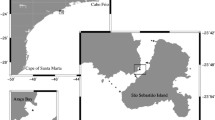Abstract
The residual currents in Tokyo Bay during four seasons are calculated diagnostically from the observed water temperature, salinity and wind data collected by Unokiet al. (1980). The calculated residual currents, verified by the observed ones, show an obvious seasonal variable character. During spring, a clear anticlockwise circulation develops in the head region of the bay and a strong southwestward current flows in the upper layer along the eastern coast from the central part to the mouth of the bay. During summer, the anticlockwise circulation in the head region is maintained but the southwestward current along the eastern coast becomes weak. During autumn, the preceding anticlockwise circulation disappears but a clockwise circulation develops in the central part of the bay. During winter, the calculated residual current is similar to that during autumn. As a conclusion, the seasonal variation of residual current in Tokyo Bay can be attributed to the variation of the strength of two eddies. The first one is the anticlockwise circulation in the head region of the bay, which develops in spring and summer and disappears in autumn and winter. The second one is the clockwise circulation in the central part of the bay, which develops in autumn and winter, decreases in spring and nearly disappears in summer.
Similar content being viewed by others
References
Arakawa, A. (1966): Computational design for long-term numerical integration of the equation of motion: Two dimensional incompressible flow. Part 1.J. Comput. Phys. 1, 119–143.
Endoh, M. (1977): Formation of thermocline front by cooling of the sea and inflow of the fresh water.J. Oceanogr. Soc. Japan,33, 6–15.
Guo, X. and T. Yanagi (1994): Three dimensional structure of tidal currents in Tokyo Bay, Japan.La mer,32, 173–185.
Guo, X. and T. Yanagi (1995): Wind-driven current in Tokyo Bay, Japan during winter.La mer,33, 51–64.
Ikeda, K., M. Matsuyama and M. Tsuji (1981): Effect of the wind on the current in Tokyo Bay.Umi to Sora,57(1), 31–40 (in Japanese with English abstract).
Nagashima, H. and M. Okazaki (1979): Observations of temperature, salinity and current velocity at the mouth of Tokyo Bay in winter.Bull. Coast. Oceanogr.,16(2), 76–86 (in Japanese).
Oonishi, Y. (1975): Development of the current induced by the topographic heat accumulation (I).J. Oceanogr. Soc. Japan,31, 243–254.
Oonishi, Y. (1978): The numerical research—its methods. p 246–271. InOceanography as an Environmental Science, Vol. 2, ed. by S. Horibe, Tokyo Univ. Press, Tokyo (in Japanese).
Suginohara, N. (1978): The numerical research—its methods. p. 234–245. InOceanography as an Environmental Science, Vol. 2, ed. by S. Horibe, Tokyo Univ. Press, Tokyo (in Japanese).
Unoki, S. (1985): Tokyo Bay—its physical aspect. p. 344–361. InCoastal Oceanography of Japanese Islands, Tokai University Press, Tokyo, 1106 pp. (in Japanese).
Unoki, S. and M. Kishino (1977): Averaged oceanic condition and water exchange in Tokyo Bay.Report of Physical Oceanography Laboratory in Physical-Chemical Institute, No. 1, 89 pp (in Japanese).
Unoki, S., M. Okazaki and H. Nagashima (1980): The circulation and oceanic condition in Tokyo Bay.Report of Physical Oceanography Laboratory in Physical-Chemical Institute, No. 4, 262 pp. (in Japanese).
Yanagi, T. and S. Igawa (1992): Diagnostic numerical model of residual flow in the coastal sea—An example of adoption to Suo-Nada and Iyo-Nada.Bull. Coast. Oceanogr.,30(1), 12–19 (in Japanese with English abstract).
Yanagi, T. and M. Shimizu (1993): Sedimentation processes in Tokyo Bay, Japan.La mer,31, 91–101.
Yanagi, T., A. Isobe, T. Saino and T. Ishimaru (1989): Thermohaline front at the mouth of Tokyo Bay in winter.Cont. Shelf Res.,9, 77–91.
Yanagi, T., S. Okada, T. Ishimaru and T. Saino (1991): Behavior of high turbidity water outflow from Tokyo Bay in Summer.La mer,29, 45–51.
Author information
Authors and Affiliations
Rights and permissions
About this article
Cite this article
Guo, X., Yanagi, T. Seasonal variation of residual current in Tokyo Bay, Japan —diagnostic numerical experiments—. J Oceanogr 52, 597–616 (1996). https://doi.org/10.1007/BF02238323
Received:
Revised:
Accepted:
Issue Date:
DOI: https://doi.org/10.1007/BF02238323



